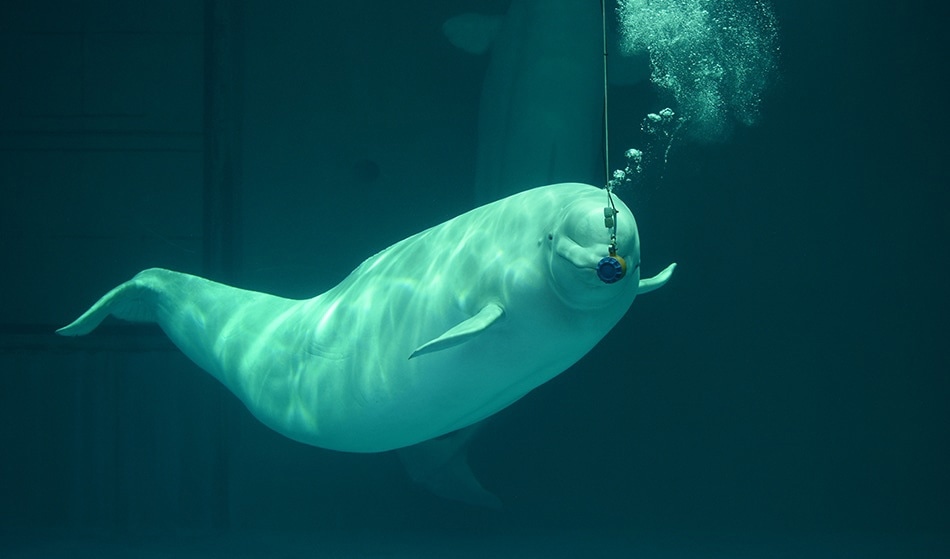Jun 20 2012

Image Credits: bluehand/shutterstock.com
A hydrophone is an underwater microphone designed to monitor underwater noise. A typical hydrophone works by converting a sound wave into an electrical voltage by detecting changes in pressure in the surrounding environment. The speed and distance at which a sound wave travels through water will be proportional to the pressure changes, which will determine the nature of the electrical output that is transmitted.
Piezoelectric material is ideal for making hydrophones. They can change their form and help generate an electrical potential in response to mechanical or external pressure changes. When an electrical voltage is applied to the crystalline ceramic material, the crystalline structure aligns, becomes anisotropic, and carries an electrical charge.
A typical hydrophone has a transducer. This transducer is crucial for converting the incoming sound waves into an electrical voltage. Use of a piezoelectric transducer as an alternative to crystal material is now a popular option in modern-day hydrophone technology.
A hydrophone with a single transducer has a circular conical shape that reflects incoming sound waves which in turn allows the hydrophone to be positioned at varying locations and depth. Figure 1 illustrates how a typical hydrophone is applied underwater to track sound waves from varying sources.
The only problem with a single transducer is that signals from other directions interfering with the main signal cannot be subtracted and this can obscure data about the location of the desired signal. While a hydrophone can detect sound waves in the air, it is not as sensitive with airborne sounds because of its acoustic impedance is designed specifically for sound detection in water.
Figure 1. Open-water monitoring using a hydrophone.
Array Hydrophones
Array hydrophones (streamers - built of multiple transducers) are all wired to receive a large sound signal collectively. The transducers are packed together in a tube with oil, which aids the collection of pressure waves entering the hydrophone. Pre-amplifiers are often used to enhance the electrical signal and limit the potential of noise contamination from additional components to the hydrophone.
Temperature Change and Hydrophone Sensitivity
It is important to remember that sound in water is affected by the temperature of the water. Warm surface water is less dense and so sound traveling through the water to the surface will refract and becomes trapped, a phenomenon referred to as a surface duct.
As most hydrophones are used in an open-water environment, they are typically exposed to temperature and pressure variations, and hence, the technology needs to be wired to account for variations and so to provide an accurate picture of sound location.
The sensitivity of hydrophones can be determined by the voltage produced by a hydrostatic pressure wave. A useful parameter in choosing piezoelectric materials to be used in hydrophones is the voltage coefficient, which links the electric field and the applied hydrostatic strain. Another widely used parameter is the hydrostatic strain coefficient, which refers to polarization resulting from changes in stress.
Calibration methods such as comparison or substitution can also be applied; however, this method does require calibrating the transducers over a full range of environmental conditions.
Applications of Hydrophones
The applications of hydrophones typically involve positioning the hydrophone on the seafloor or parallel to a boat under water. Sound waves traveling in from various distances will reach the hydrophone at different times, and this time difference helps locate the source of a signal wave.
Marine environmental research often deploys array hydrophones to track underwater marine life and their behavioral patterns. Underwater surveillance can also be managed using array hydrophones. For example, the US Navy’s sound surveillance system consisting of a series of hydrophone arrays were placed in the Atlantic Ocean in the 1950s to monitor submarine activity during the cold war.
The video below demonstrates the different sounds that are traced by a hydrophone array. The video illustrates SOFAR channeling of the sound wave to the hydrophone array.
Hydrophone tsunami earthquake marine
Use of a marine hydrophone array to record sound waves.
Submarines also use hydrophones to track the position of an incoming, underwater remotely operated vehicle (ROV) to avoid collisions. The hydrophone is placed on top of a submarine, facing down at a 25 to 30-degree angle to allow for accurate tracking of sound. By tracking the location of an incoming boat, the submarine crew can remain in a safe position underwater until the surrounding area is safe enough for the crew to resume to the surface without colliding with an ROV.
Additional applications of a hydrophone include the following:
- Environmental monitoring
- Navigation/positioning systems
- Underwater exploration
- Towed arrays
- Deep ocean operation
Hydrophones are becoming highly useful for tracking patterns of micro-earthquakes and underground volcanic activity. A recent publication by Dziak R.P. et al. (2012) has revealed how the application of ocean-bottom hydrophones helped measure an increase in seismic activity over several years to the point at which a volcanic eruption was observed in April 2011.
Studies have also hinted on the development of an autonomous hydrophone called the Quasi-Eulerian hydrophone, or QUEphone. It is a tether-free floating hydrophone that can maintain an almost fixed position in ocean water and detect acoustic events in near-real time. It can continuously monitor sound and transmit data by repeatedly traveling between the seafloor and the sea surface.
Sources and Further Reading
This article was updated on the 30th May, 2019.